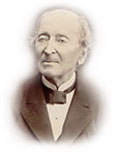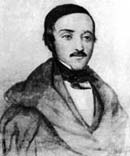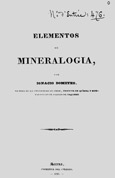Ignaсy Domeyko
Overview
 Ignaсy Domeyko (b. 31 July
1802 – d. 23 January 1889), one of the most world-known Belarusians, a participant in the
liberation movement in Belarus, the national hero of Chile, a world-famous scientist,
mineralogist, the Rector of the University of Chile. He left a significant mark in
many areas of human knowledge, such as mineralogy, geology, chemistry, metallurgy,
geography, ethnography, botanics and zoology, as well as considerably contributed to the
organization of higher education system in Chile.
Ignaсy Domeyko (b. 31 July
1802 – d. 23 January 1889), one of the most world-known Belarusians, a participant in the
liberation movement in Belarus, the national hero of Chile, a world-famous scientist,
mineralogist, the Rector of the University of Chile. He left a significant mark in
many areas of human knowledge, such as mineralogy, geology, chemistry, metallurgy,
geography, ethnography, botanics and zoology, as well as considerably contributed to the
organization of higher education system in Chile.
Ignaсy Domeyko was born at Medviadka Manor, Novogrudok district (now in Korelichi district, Grodno region, Belarus) into the family of a former judge in the Novogrudok voivodeship. At the age of seven after his father’s death he came under the guardianship of his uncles, highly educated people, and lived on their estates at Zhyburtovshchina and Ozerany (now in Diatlovo district, Grodno region). At the age of ten, he entered a local grammar school founded at the Piarist college noted for its excellence in education, in the town of Shchuchin.
In 1816 Ignaсy Domeyko was admitted to the University of Vilno (Vilnius) to study mathematics and physics, where he also obtained knowledge in topography, architecture, foreign languages, history, and literature. In 1882 he defended his thesis and obtained a master’s degree in philosophy.
During student years Domeyko became friends with the poet and public figure, Adam Mitskevich, the poet and ethnographer, Jan Chechot, and the revolutionary poet and naturalist, Tomash Zan. They all were involved in the secret student societies of Philomathes and Philarets, who sought to prepare young people in various activities for the wellbeing of their native land. They placed high emphasis on national self-awareness and humanistic ideas, promoted knowledge and science as highest values, and stood up against the officialdom of tsarist Russia in education, criticizing despotism, surfdom and the feudal absolutist order. In 1820 Ignaсy Domeyko joined the Philomathes under the secret name of Zhegot. Later Adam Mitskevich would give this name to one of the heroes in his long poem called “Dziady”; besides, his famous epic poem “Pan Tadeush” was originally designed under the title of “Zhegot”. In 1823 the secret societies were disbanded; their members including Ignaсy Domeyko (in all, nearly a hundred) were arrested. Domeyko was exiled under police supervision to the estate of his uncle.
The former Philomathes were not accepted for government service. For six years Domeyko had been managing the estates of Zhyburtovshchina and Zapolie (now in Lida district, Grodno region). He obtained knowledge of agriculture from the books ordered in Germany. In these years he was also occupied with experimental gardening, veterinary medicine, and treating the sick villagers. Besides, he made translations from various languages.
 Ignaсy
Domeyko was a participant in the national uprising of 1830-1831 in Poland, Belarus and
Lithuania against the tsarist Russia. After a defeat, together with the insurgent army he
crossed the Russian-Prussian border and layed down arms.
Ignaсy
Domeyko was a participant in the national uprising of 1830-1831 in Poland, Belarus and
Lithuania against the tsarist Russia. After a defeat, together with the insurgent army he
crossed the Russian-Prussian border and layed down arms.
Being forced to stay in a foreign land, from 1832 Domeyko lived in Paris and was active in the public life of the Belarusian, Polish and Lithuanian emigre communities. Later he attended the Sorbonne, College de France, and then he studied chemistry and geology at the Ecole des Mines in Paris, graduating in 1837 with a diploma in mining engineering.
In 1838 Domeyko left for Chile, being contracted for six years to teach chemistry and
mineralogy. Instead he stayed in this South American country for almost half a century.  For several years he had lectured at a mining school in
the town of Coquimbo, founded a meteorological station, and created an ethnographic
museum. During his repeated journeys about the country he studied the geology and
mineralogy of the Andes, the Atacama Desert, and the province of Auracania in southern
Chile and examined the daily life of the local people, the Auracanian Indians (Mapuches),
whom he described in his book.
For several years he had lectured at a mining school in
the town of Coquimbo, founded a meteorological station, and created an ethnographic
museum. During his repeated journeys about the country he studied the geology and
mineralogy of the Andes, the Atacama Desert, and the province of Auracania in southern
Chile and examined the daily life of the local people, the Auracanian Indians (Mapuches),
whom he described in his book.
The eager activity of Ignaсy Domeyko in Coquimbo was noticed by the scholarly
community and the government of Chile: in 1847 he was invited to lecture at the University
of Chile in Santiago.  In the years 1867-1883 he was the university’s rector and was
directly involved in the reforming of higher education in the country. He many times
conducted research expeditions in the Andes, studied volcanoes, discovered silver and
copper mines, organized the production of gold and caliche, introduced first in Latin
America the metric system of weights and measures, and authored many textbooks and
scholarly treatises that were published in the learned journals of Paris. At retirement,
the Government of Chile granted him a life-long pension, the highest in the country, that
exceeded even the rewards given to generals who fought for the independence of this
country.
In the years 1867-1883 he was the university’s rector and was
directly involved in the reforming of higher education in the country. He many times
conducted research expeditions in the Andes, studied volcanoes, discovered silver and
copper mines, organized the production of gold and caliche, introduced first in Latin
America the metric system of weights and measures, and authored many textbooks and
scholarly treatises that were published in the learned journals of Paris. At retirement,
the Government of Chile granted him a life-long pension, the highest in the country, that
exceeded even the rewards given to generals who fought for the independence of this
country.
In 1884 Ignaсy Domeyko managed to fulfill his old dream of visiting Belarus. His
departure was honoured by his many friends and pupils, among whom were the known
politicians, university faculty and students. On his way to Belarus he stayed for a time in Cracow
and Warsaw, where he was greeted with great enthusiasm, yet he longed to see soon his
homeland. In his diary he wrote, “…I could feel blood pounding in my temples at the
thought that i would soon see my home and that i hadn’t reached my destination yet… Here
is the Bug, the nightly Brest – I am now in Litva!” (a historical name for the
biggest part of modern-day Belarus it had before the late 19th century). In his Domeyko
about the uprising of 1830-1831, Domeyko does not omit to mention, almost in each case,
the nationality of this or that insurgent. He clearly distinguishes between the
“Crowns” (i.e. the Poles), “Zhmudins” (present-day Lithuanians) and
“our Litvins” (present-day Belarusians). On 14 June 1887 the Jagiellonian
University in Cracow awarded the title of Doctor honoris causa of medicine to the
“Litvin”, as indicated in the diploma, Ignaсy Domeyko.
On his way to Belarus he stayed for a time in Cracow
and Warsaw, where he was greeted with great enthusiasm, yet he longed to see soon his
homeland. In his diary he wrote, “…I could feel blood pounding in my temples at the
thought that i would soon see my home and that i hadn’t reached my destination yet… Here
is the Bug, the nightly Brest – I am now in Litva!” (a historical name for the
biggest part of modern-day Belarus it had before the late 19th century). In his Domeyko
about the uprising of 1830-1831, Domeyko does not omit to mention, almost in each case,
the nationality of this or that insurgent. He clearly distinguishes between the
“Crowns” (i.e. the Poles), “Zhmudins” (present-day Lithuanians) and
“our Litvins” (present-day Belarusians). On 14 June 1887 the Jagiellonian
University in Cracow awarded the title of Doctor honoris causa of medicine to the
“Litvin”, as indicated in the diploma, Ignaсy Domeyko. 
For four years Domeyko had lived on his home estate at Zhyburtovshchina and in the meantime visited other memorable places in Belarus: Medviadka, Mir, and Kroshin. One of the last Philarets, he was welcomed everywhere with great interest; he had talks with local villagers in Belarusian, the language he did not forget despite a half-century absence. During his stay in Belarus he several times visited Paris and was once in Rome and Jerusalem.
Ignaсy Domeyko died on 23 January 1889 soon after return to Santiago. The government declared him the national hero of Chile. On the day of his funeral the national mourning was announced in the country.
The many-sided activity of Ignaсy Domeyko brought him a universal recognition, his
scholarly legacy being of especial importance. He authored 130 scientific works. Many of
his textbooks were used and are still used to teach students in Chile, Peru and Mexico. In
all, his bibliography totals 4,500 titles, including monographs, articles, textbooks,
manuals, letters, and reviews of his works, as well as biographical articles, essays and
poetic pieces written about him. In Europe and America there are over 70
monuments and commemorative plaques bearing the name of Ignaсy Domeyko. Named in his
honour are the mineral Domeykite, the Chilean ammonite, a new species of rubber-bearing
plant, a violet, an azalia, a fossil snail and shellfish, a peak and a range of mountains
in the Andes (Cordilliera-Domeyko), a town in the province of Auracania in southern Chile,
a village near the town of Antofagasta in northern Chile, a university college in
Valparaiso, a national library in Santiago, a mineralogical museum at the University
of La Serena, a number of mines, streets, squares, post stations, public and sports
organizations, funds and scholarships. In Chile, the statue of Domeyko was erected in
Santiago and a medal was coined in his honour.
In Europe and America there are over 70
monuments and commemorative plaques bearing the name of Ignaсy Domeyko. Named in his
honour are the mineral Domeykite, the Chilean ammonite, a new species of rubber-bearing
plant, a violet, an azalia, a fossil snail and shellfish, a peak and a range of mountains
in the Andes (Cordilliera-Domeyko), a town in the province of Auracania in southern Chile,
a village near the town of Antofagasta in northern Chile, a university college in
Valparaiso, a national library in Santiago, a mineralogical museum at the University
of La Serena, a number of mines, streets, squares, post stations, public and sports
organizations, funds and scholarships. In Chile, the statue of Domeyko was erected in
Santiago and a medal was coined in his honour.
 In Belarus, a museum was founded on the
former estate of our famous fellow-countryman in the village of Zapolie, Lida district.
His memory is also preserved at school museums in the village of Velikaia Medviadka,
Korelichi district, and Krupovo, Lida district; a street in the village of Krupovo also
bears his name.
In Belarus, a museum was founded on the
former estate of our famous fellow-countryman in the village of Zapolie, Lida district.
His memory is also preserved at school museums in the village of Velikaia Medviadka,
Korelichi district, and Krupovo, Lida district; a street in the village of Krupovo also
bears his name.
On the 200th anniversary of Domeyko’s birth, UNESCO declared the year of 2002 to be “Ignaсy Domeyko Year”. The commemorative events were held in many countries, especially those associated with his life and activities. In Belarus, numerous scholarly conferences were held, his name was attached to a number of newly-established scholarships, commemorative plaques were installed in places where he once lived. The Minsk-based publishing house, Belaruski Knigazbor, published the book of his diaries called “My Journeys”.
Our website offers a list of documents relating to Ignaсy Domeyko which are preserved at the National Historical Archives of Belarus in Grodno — 14 records selected from four record groups. The language of documents is Russian, Polish, French, German and English. Documents dated 1824, 1826, 1833-1836, and 1841 concern Domeyko’s participation in the liberation movement in Belarus. The survey of documents was prepared by R.F. Goriacheva, director assistant at the National Historical Archives of Belarus in Grodno.
